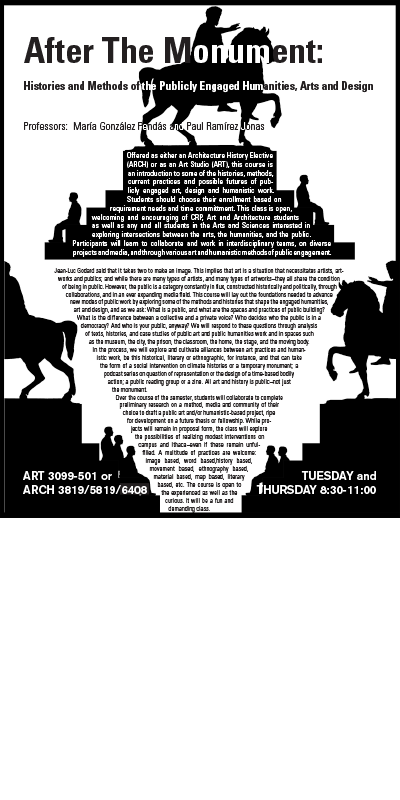After The Monument
Fall 2022

Histories and Methods of the Publicly Engaged Humanities, Arts and Design
Offered as either an Architecture History Elective (ARCH) or as an Art Studio (ART), this course is an introduction to some of the histories, methods, current practices and possible futures of publicly engaged art, design and humanistic work. Students should choose their enrollment based on requirement needs and time committment. This class is open, welcoming and encouraging of CRP, Art and Architecture students as well as any and all students in the Arts and Sciences interested in exploring intersections between the arts, the humanities, and the public. Participants will learn to collaborate and work in interdisciplinary teams, on diverse projects and media, and through various art and humanistic methods of public engagement.
**
Jean-Luc Godard said that it takes two to make an image. This implies that art is a situation that necessitates artists, artworks and publics; and while there are many types of artists, and many types of artworks–they all share the condition of being in public. However, the public is a category constantly in flux, constructed historically and politically, through collaborations, and in an ever expanding media field. This course will lay out the foundations needed to advance new modes of public work by exploring some of the methods and histories that shape the engaged humanities, art and design, and as we ask: What is a public, and what are the spaces and practices of public building? What is the difference between a collective and a private voice? Who decides who the public is in a democracy? And who is your public, anyway? We will respond to these questions through analysis of texts, histories, and case studies of public art and public humanities work and in spaces such as the museum, the city, the prison, the classroom, the home, the stage, and the moving body. In the process, we will explore and cultivate alliances between art practices and humanistic work, be this historical, literary or ethnographic, for instance, and that can take the form of a social intervention on climate histories or a temporary monument; a podcast series on question of representation or the design of a time-based bodily action; a public reading group or a zine. All art and history is public–not just the monument.
Over the course of the semester, students will collaborate to complete preliminary research on a method, media and community of their choice to draft a public art and/or humanistic-based project, ripe for development on a future thesis or fellowship. While projects will remain in proposal form, the class will explore the possibilities of realizing modest interventions on campus and Ithaca–even if these remain unfulfilled. A multitude of practices are welcome: image based, word based,history based, movement based, ethnography based, material based, map based, literary based, etc. The course is open to the experienced as well as the curious. It will be a fun and demanding class.


